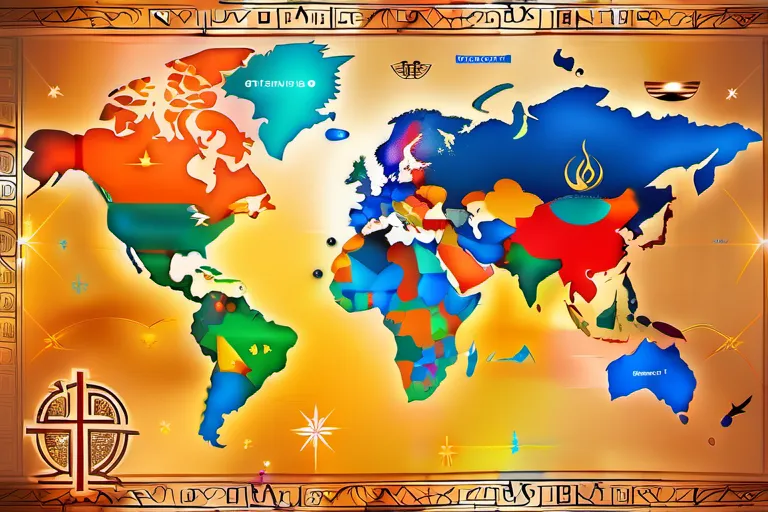Explore the most popular religions, their origins, beliefs, and global distribution.
This article provides an overview of the top religions in the world, delving into their history, core beliefs, practices, and global influence. From Christianity to Islam, Buddhism, Hinduism, and more, we’ll explore each religion’s unique aspects and what makes them significant.
The History of Christianity
The history of Christianity begins in the first century AD and has since shaped cultures, societies, and individual lives around the globe. It all started in a small region known as Galilee, where Jesus Christ and his disciples preached a message that would later revolutionize the world. How did this tiny movement grow into one of the largest religions on Earth?
Christianity originated from Judaism, sharing many of its roots but expanding its teachings to include concepts like salvation through faith in Jesus as the Messiah. The early followers faced persecution and uncertainty, yet their message spread rapidly due to effective missionary work and the translation of the New Testament into various languages.
Key figures such as Saint Paul played crucial roles in spreading Christianity beyond its Jewish roots. His letters to various churches introduced non-Jews to Christian teachings, helping to establish a more inclusive religious movement. The Church’s growth was also bolstered by important councils like Nicaea in 325 AD, which helped define core Christian doctrines and beliefs.
By the time of Constantine the Great, Christianity had become so widespread that he recognized its potential as a unifying force within his empire. This led to the Edict of Milan in 313 AD, granting religious tolerance throughout the Roman Empire. From this point on, Christianity began to integrate deeply into European society and culture.
As Christianity spread across continents through missionary efforts, it encountered diverse cultures and religions, leading to both conflicts and syncretisms. Today, with over 2 billion followers worldwide, Christianity remains a dominant force in global religious and cultural landscapes, its history intertwined with the very fabric of human civilization.
Islam: The Second Largest Religion
Islam: The Second Largest Religion
Imagine the world as a vast ocean, with each religion like a significant wave that shapes the landscape. Among these waves, Islam stands out as one of the most powerful and influential. With its origins traced back to the 7th century in Mecca, Saudi Arabia, Islam has since become the second-largest religion globally, with over 1.9 billion followers worldwide.
So, what is it about this faith that has allowed it to spread so far and wide? Perhaps we can find some answers by exploring its core beliefs and practices. One of the foundational elements of Islam is the belief in one God, Allah. This monotheistic view sets Islam apart from many other religions, creating a clear path for understanding the world.
The five pillars of Islam serve as a framework for practicing Muslims: declaration of faith (shahada), prayer (salat), giving alms (zakat), fasting during Ramadan (sawm), and pilgrimage to Mecca (hajj). Each pillar acts like a stone in a mosaic, creating a cohesive structure that guides the faithful. These practices are not just rituals but a way of life.
But what about the history? How did Islam spread so rapidly from its origins in Arabia to become one of the most widespread religions on the planet? The answer lies in both military conquests and peaceful proselytization. As early as the 8th century, Islamic scholars and soldiers embarked on journeys that not only expanded the reach of their faith but also enriched the cultures they encountered with knowledge, art, and philosophy.
Today, Islam is practiced across diverse regions, from the Middle East to Africa, Asia, Europe, and beyond. Its influence can be seen in architecture, literature, science, and social structures. The spread of Islam has been a transformative force, shaping societies and cultures in profound ways.
As we delve deeper into the heart of Islam, one cannot help but wonder: what is it that compels millions to follow this path every day? Is it the promise of spiritual fulfillment or the call to social justice and humanitarian action?
Whether you are a follower or simply curious about this vast ocean of faith, understanding Islam provides insights into not just a religion but also a way of life that continues to shape the modern world.
Buddhism: The Path to Enlightenment
Buddhism, often described as the path to enlightenment, has captivated hearts and minds for centuries. Imagine a journey through time, where you witness the birth of this profound spiritual tradition in ancient India around the 5th century BCE. Could it be that Buddhism’s origins stem from the life-changing experience of Siddhartha Gautama, later known as Buddha? His quest for understanding and peace led him to leave behind a life of luxury, embarking on a journey that would change history.
The core teachings of Buddhism revolve around the Four Noble Truths and the Eightfold Path. Are these principles just another set of rules or do they hold the key to liberation from suffering? The Four Noble Truths—understanding suffering, the cause of suffering, the end of suffering, and the path that leads to the cessation of suffering—are foundational. The Eightfold Path, consisting of right understanding, right intention, right speech, right action, right livelihood, right effort, right mindfulness, and right concentration, serves as a practical guide for everyday life.
Buddhism has spread like wildfire across Asia, finding homes in diverse cultures from Japan to Sri Lanka. How did Buddhism adapt to local customs while maintaining its core principles? The Theravada tradition, prevalent in Southeast Asian countries, emphasizes personal enlightenment and the study of the original teachings. In contrast, the Mahayana tradition, widespread across East Asia, focuses on compassion and includes numerous bodhisattvas who vow to help others reach enlightenment first.
The practice of mindfulness meditation has become increasingly popular worldwide, offering a glimpse into the transformative power of Buddhist practices. Could it be that the simple act of sitting in silence helps individuals find clarity amidst life’s chaos? Buddhism’s teachings continue to resonate with those seeking deeper meaning and purpose in their lives, making its influence on modern thought profound and enduring.
Hinduism: The Oldest Religion
Can you imagine a religion that has been around for over 4,000 years? That’s right; we’re talking about Hinduism, often referred to as the ‘oldest living religion.’ Imagine walking through the streets of ancient India, witnessing people performing rituals and ceremonies that have remained unchanged for centuries. It’s like stepping back in time into a vibrant tapestry of history.
Hinduism is not just one religion but a complex mosaic of beliefs and practices that vary widely from region to region. At its core, Hinduism centers around the concept of ‘dharma,’ which encompasses duties, rights, laws, conduct, virtues, and right way of living. This overarching principle guides individuals in their daily lives and spiritual journey.
The origins of Hinduism are shrouded in mystery, with its earliest roots dating back to the Indus Valley Civilization around 3000 BCE. The Rigveda, one of the oldest religious texts, offers insights into early Hindu beliefs, practices, and rituals. Over time, the religion evolved through various periods such as the Vedic period, the Epic period (epics like the Ramayana and Mahabharata), and the classical period.
One of the most fascinating aspects of Hinduism is its rich pantheon of gods and goddesses. From Shiva, the destroyer, to Vishnu, the preserver, each deity represents different facets of the universe and human experience. Devotees often engage in puja (worship), chanting, meditation, and pilgrimage to seek blessings and spiritual growth.
But Hinduism is not just about gods; it’s also deeply intertwined with Indian culture and society. The caste system, though controversial today, has historically structured social life. Despite its complexities, many modern Hindus see the caste system as evolving towards a more inclusive and egalitarian society.
How does one navigate such an intricate religion? For some, it’s about finding harmony between the physical and spiritual worlds. For others, it’s about living a righteous life and achieving moksha, or liberation from the cycle of rebirth. The diversity within Hinduism means there are countless paths to enlightenment.
As we delve deeper into the world of religions, remember that each one offers unique insights into human spirituality and the search for meaning. Whether you’re exploring the ancient roots of Hinduism or considering its impact on Indian culture, it’s clear that this religion has left an indelible mark on history and continues to shape lives today.
Other Major World Religions
After delving into the ancient roots of Hinduism, let’s now explore other significant religions that have shaped human history and culture across different continents. From the Sikhism in South Asia to the Judaism with its profound impact on Western civilization, each of these faiths carries a unique story worth uncovering.
Sikhism, founded by Guru Nanak in the 15th century, is often called the “Religion of Peace and Truth.” It emphasizes unity among all people and rejects caste distinctions. Sikhism’s holy scripture, Guru Granth Sahib, serves not only as a religious text but also as a community center where Sikhs gather for worship and social interactions. The Golden Temple in Amritsar is like a beacon of light, attracting visitors from around the world who seek spiritual solace.
Judaism, the faith that predates many others, has profoundly influenced Western thought, ethics, and law. It’s the religion of the ancient Israelites, led by prophets like Moses and Joshua. Jewish traditions, such as keeping kosher and observing Sabbath, continue to shape daily life for millions worldwide. The story of the Temple in Jerusalem is a testament to their history and the resilience of their faith, which has endured through centuries of persecution and diaspora.
The Bahá’í Faith, founded in 19th century Persia (now Iran), teaches that all religions come from one source and are intended to guide humanity. It emphasizes unity among people regardless of race or nationality. The Bahá’í House of Worship in India, known as the Lotus Temple, is a stunning symbol of this belief system. Its nine petals rise gracefully from the ground, representing the petals of a lotus flower, which opens to receive the sun – a metaphor for humanity’s quest for knowledge and understanding.
Lastly, let’s not overlook Zoroastrianism, one of the world’s oldest monotheistic religions. Founded by Zoroaster in ancient Persia, it teaches that there is only one God, Ahura Mazda, who created a material world and an evil spirit, Angra Mainyu. Temples known as Fire Temples are central to their worship, where sacred fire burns perpetually, symbolizing purity and the light of truth.
These religions, among others, weave a tapestry of beliefs that shape our global communities. Each one brings unique insights and values that contribute to human diversity and coexistence. Understanding these faiths not only broadens our knowledge but also enhances our ability to appreciate the rich fabric of world cultures.
Religious Diversity: A Global Perspective
How does one begin to understand the vast tapestry of religious diversity that spans our globe? Imagine, for a moment, the world as a giant canvas, where each stroke of paint represents a different belief system. Now, let’s take a closer look at how these strokes are distributed across this canvas.
Where Do Religions Flourish?
- In India, for instance, you can find the vibrant hues of Hinduism and Buddhism blending harmoniously with Jainism and Sikhism. It’s like a colorful mosaic where every piece tells its own story but fits perfectly into the whole.
- Muslim-majority countries in the Middle East showcase another distinct palette, dominated by Islam with rich tapestries of Sufi traditions woven throughout.
- In sub-Saharan Africa, Christianity often interweaves with indigenous beliefs, creating a unique blend that is both familiar and strange to outsiders. It’s as if different threads are stitched together in intricate patterns, each adding its own texture and depth.
What Are the Implications of This Diversity?
- Can you imagine how this diversity impacts society? Does it lead to conflict or cooperation? In some regions, religious differences can act as a barrier, causing tension. But in others, they bring communities together, fostering mutual respect and understanding.
- For example, in Europe, where Christianity has long been dominant, the rise of Islam due to immigration has prompted discussions on integration and tolerance. It’s like bringing two different types of soil together; if you’re not careful, the seeds might not grow well.
A Global Perspective
- From a global standpoint, religious diversity is more than just an academic curiosity—it’s a dynamic force shaping our world. It influences politics, economics, and social structures on a profound level. How do you reconcile the rights of individuals to practice their faith freely with the need for societal cohesion?
As we navigate this complex landscape, it’s clear that religious diversity is not just about numbers but about the rich cultural tapestry that makes our world unique. Each religion, like a different brushstroke, contributes something invaluable to the overall picture of humanity.
Conclusion
 By understanding the diversity of religions worldwide, we gain a deeper appreciation for cultural differences and shared human experiences. This knowledge fosters empathy, tolerance, and mutual respect among people of different faiths.
By understanding the diversity of religions worldwide, we gain a deeper appreciation for cultural differences and shared human experiences. This knowledge fosters empathy, tolerance, and mutual respect among people of different faiths.











